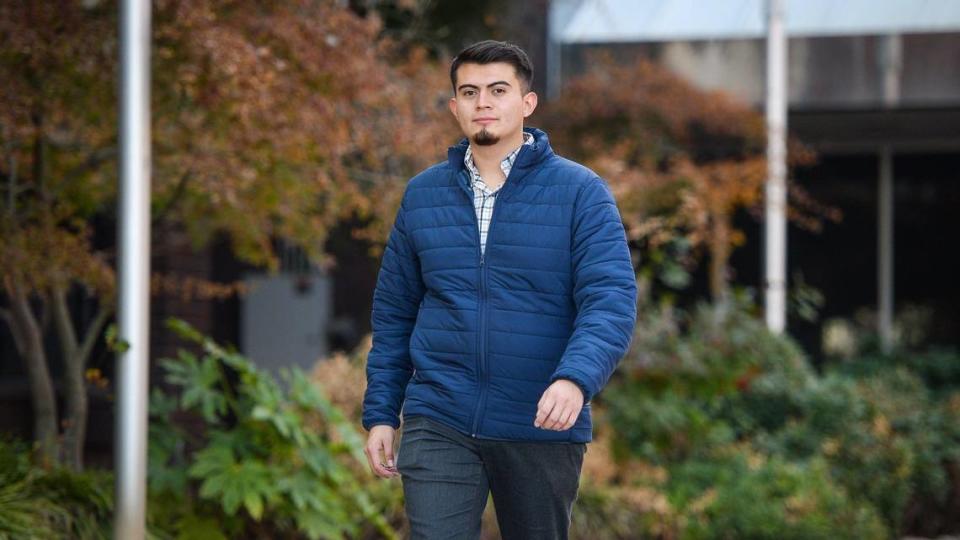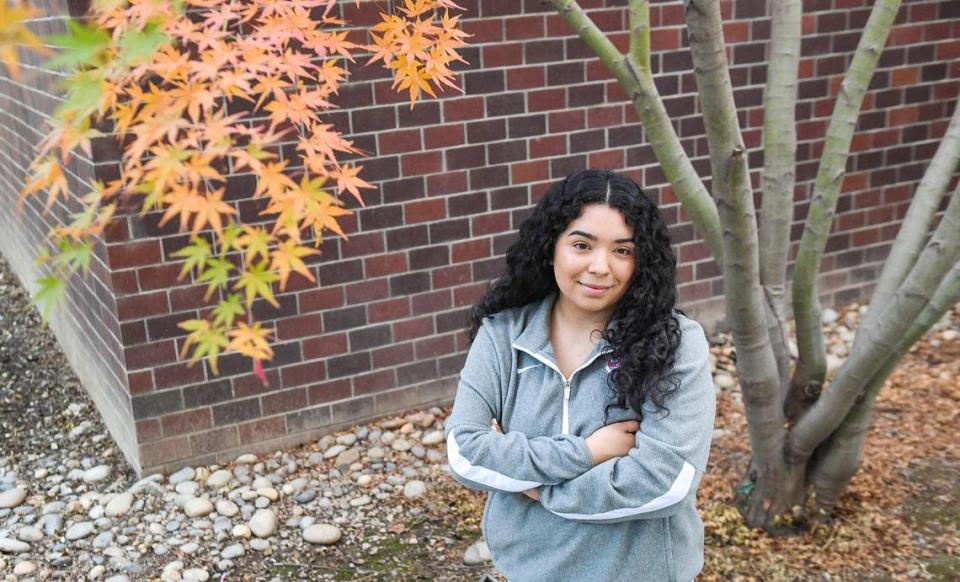California Latinos have lowest rate of college attendance. How these students succeeded
Jose Eduardo Mundo Tapia knew he wanted to go to college in the United States the day he arrived in California at age 7 from his native San Luis Río Colorado, Mexico. But Mundo Tapia, now 24, didn’t realize how challenging the journey would be once he got there.
While he had the aptitude and ambition to succeed at California State University, Fresno, he faced tremendous hurdles, due to coming from a farmworker family that struggled to make ends meet.
His financial situation deteriorated even more during his junior year at Fresno State, when he lost his job, his roommate moved out — doubling his rent — and his financial aid was reduced. He felt like the odds were increasingly stacked against him. He regularly thought about dropping out and moving back to Salinas to live with his parents.
“I fell into a state of anxiety and depression for the whole year,” said Mundo Tapia, who is now a graduate student pursuing a master’s degree in student affairs and college counseling at Fresno State. “There were many moments where I did think about going back home.”
While more Latino students are now applying, attending and graduating from college than ever before, many like Mundo Tapia still face significant barriers that have hindered their ability to succeed, according to a new report released last month from The Campaign for College Opportunity, a California-based advocacy and research organization focused on providing students with opportunities to attend and complete college.
These challenges have only been made worse by the pandemic, which has disproportionately affected the Latino community across the state, according to the report, “The State of Higher Education for Latinx Californians.”
The report analyzes the most recent trends in students pursuing and completing college degrees within the state’s public colleges and universities, including its community colleges, California State University system and University of California institutions.
Latinos in California now represent 43% of all undergraduate students in the state’s public institutions. Latinos’ graduation rates in the CSU system have doubled in the past five years from 9% to 18% for men and from 15% to 29% for women.
But Latino students still face several challenges while attending college, the report found. Many first-generation students have difficulty navigating financial aid and other resources, struggle with language barriers or receive less guidance from their families while pursuing a degree, the report showed. Latinos are also more likely to come from low-income families and continue to experience high poverty rates, report a lower sense of belonging on college campuses compared to their peers, and experience hardships due to their immigration status.
These barriers have had staggering effects. While college attendance among Latinos between ages 25 and 64 increased from 28% to 40% in the past decade, Latino adults still have the lowest levels of college attendance. Only 14% of Latinos have graduated with a bachelor’s degree, representing the lowest rates of degree attainment of any racial group in California, the report found.
Latinos’ academic achievement is critical to California’s future, the report argues.
Latinos’ access to more equitable educational opportunities will only “ensure that more of them are prepared for college, attend college, and graduate with the skills necessary to thrive personally and to contribute to the economy of our state,” the report said.
Financial stress is a challenge for Latino university students
Financial stress is a barrier to success for many Latino students, the report found.
According to the U.S. census, 24% of Latino children are growing up in households with incomes that fall below the federal poverty line, which in 2020 amounted to about $26,000 for a family of four, the report said. Latinos also make up 55% of all students in the state’s public school system, but account for 71% of socioeconomically disadvantaged students and 73% of homeless students, according to the report.
Mundo Tapia, who finished his undergraduate degree in social work in 2020, now works as an academic advisor for Fresno State’s College Assistance Migrant Program, which helps students from farmworker and migrant backgrounds get connected to mentoring, academic and financial resources. He said the center helped him significantly after he nearly dropped out during his junior year due to financial instability.
Before he knew about programs like CalFresh or ways to access food assistance, he said he reduced his food intake while he looked for another part-time job.
“It was a time of deep struggle for me,” he said. “My first instinct to save money was to just not eat as much. I would literally just have one quesadilla a day and that’s what I ate every day. I never really told my parents about it because I didn’t want them to think that I was struggling.”

The severe stress of his precarious financial situation affected his ability to concentrate in class, he said. He was unable to maintain a conversation with his friends, peers or professors, and while he was physically present, mentally he said he wasn’t there.
Eric R. Felix, an assistant professor of community college leadership for the Department of Administration, Rehabilitation, and Postsecondary Education at San Diego State University, helped analyze the findings of The Campaign for College Opportunity report. He said poverty and food insecurity pose a major risk to students, especially those like Mundo Tapia who come from low-income backgrounds and face an expectation to immediately find a job after high school to help the family make ends meet.
“When you’re struggling for food or insecure with the type of meals that you’re going to get, you’re not able to learn in the same way, it’s really difficult to focus, or to read,” he said. “These are real barriers that go beyond the classroom and speak to a societal need.”
For many first-generation students, Felix said, the pressure of overcoming poverty can be difficult to bear. They recognize their parents made enormous sacrifices by moving to the U.S. and “living up to that can create a big burden,” he said.
“That’s a lot of weight for us to carry, to think that our success in college is going to transform our families,” he said.
Community college proves key for Latino students
The report highlighted several recommendations for policymakers and college leaders to improve Latinos’ educational success in California and help close racial, ethnic and gender gaps in higher education.
Among the report’s recommendations are ensuring that community college students find a clear path to a degree or transfer to another institution. It also recommends improving community college retention and completion rates by ensuring colleges are equitably funded. These funds should be allocated based on factors such as enrollment, the number of low-income students and the number of first-generation students to support critical student services that could lead to higher graduation and transfer rates to four-year institutions.
With nearly three out of every four Latino undergraduates in California enrolled at a California community college, the schools play a critical role as “a primary point of entry and as an essential path to transfer and bachelor’s degree attainment,” the report said.

Fresno State student Jennifer Rivera, who was raised in Sanger by Mexican immigrant parents, said she feels especially grateful that her Sanger High School counselor, Fuechi Lor, encouraged her to go to community college. After graduating high school, she enrolled at Reedley Community College, though she said she initially wasn’t too thrilled about the idea.
“I remember telling my counselor, ‘I don’t want to go to community college. Community college to me is for lazy people,’” she said. “And my counselor said, ‘No, you’re going to like it. It’s going to be a new experience and you honestly won’t regret it.’ And those words from my high school counselor have been the best advice ever given to me because I don’t regret anything and I learned so much.”
Throughout her time at community college, Rivera was a part of the Student Success program, which provides academic and community-mentoring support tailored to the needs of students from diverse backgrounds. She said being a part of the program was “one of the biggest accomplishments for me as a first-generation female student.”
Rivera has one semester left at Fresno State before she completes her bachelor’s degree in psychology. She’s hoping to apply to the university again next fall to pursue a master’s degree in counseling.
She hopes to become a high school guidance counselor so she can inspire future generations of students from diverse and underrepresented backgrounds to pursue a college education. She said many Latino high school students could use more support and guidance. She hopes she can make a difference in students’ lives, the same way Lor made a difference in her’s.
“He was one of my biggest supporters in high school and he’s actually one of the biggest reasons why I want to become a high school counselor,” she said. “He made a difference in my life. I want to have a relationship with students one day where they say, ‘Okay, well, she did it, so I can do it too.’ That’s my biggest goal.”

